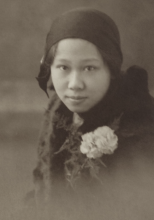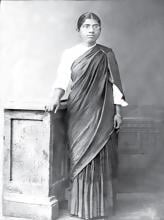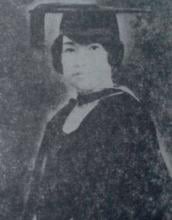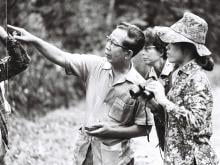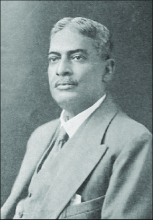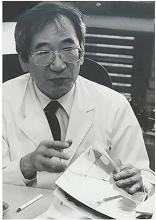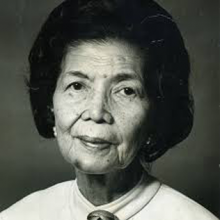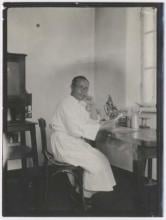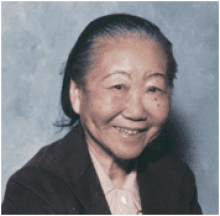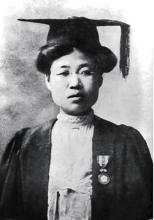Medicine
News

19 Apr 2006
Summaries of newsworthy stories from Nature Vol 440, No 7087 Dated 20 April 2006 including Evolutionary pathways lead to same destination and Invisible skeleton
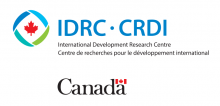
18 Apr 2006
There will be a media briefing on the Partnership and the two research projects at the Friendship Hotel, Bai Shi Qiao Road, Haidian District, Beijing on Tuesday evening, April 25th, 2006, 5.30 – 6.30PM. IDRC representatives and key national officials and researchers will be available for interview by the press.
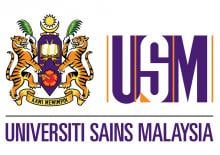
16 Apr 2006
Typhoid is a major public health problem caused by the bacteria Salmonella typhi and transmitted via food. The current method for diagnosis of typhoid carriers takes 2-7 days, has low isolation rate and labour intensive. This EZTYPHI Carrier DNA kit will be able to do this in a single tube within 3 hours and is cost effective.

14 Apr 2006
Unlikely to infect people; Bird flu, rates, oil pose risks Asia’s growth; Outbreak in Myanmar raises alarm; Viet Nam can’t be over-confident; Restoring wetlands key..; Britain's method questioned; Egypt - 12th case; Indonesia's 33rd case; Thailand 'clean' but spreading; China, markets worry; Bird flu seen unlikely in Japan sparrow deaths

13 Apr 2006
Nature Publishing Group (NPG) and the Shanghai Institutes for Biological Sciences (SIBS) today announce the appointment of Dr Dangsheng Li as the new Deputy-Editor-in-Chief for China’s premier life science journal, Cell Research (CR).

13 Apr 2006
Canada’s International Development Research Centre (IDRC) is pleased to announce its support of the Asia Research Partnership on Pandemic Influenza. Pandemic experts, scientists and Asian national granting councils will meet in Beijing, China, on April 24-26 to formalize the Partnership.

12 Apr 2006
Summaries of newsworthy papers from Nature. Vol.440 No.7086 Dated 13 April 2006 including Watching synpases at work; The ‘impossible’ microbes; Doting mums let their kids eat them; The gas that won't settle down; A new spin on Vega; Catfish hunts on land

12 Apr 2006
A new idea about why the experimental antibody drug TGN1412 had devastating effects on humans that had not been seen in animal tests is put forward in an exclusive special news report by Nature this week.

09 Apr 2006
The Grand Prix of the 34th International Exhibition of Inventions, New Techniques and Products was awarded by the International Jury to researchers from the Malaysian Institute for Nuclear Technology, for their manufacturing process for organic medical material which does not damage or discolour and produces no toxic gases during sterilisation

09 Apr 2006
Summaries of newsworthy papers published online on 9 April 2006 by Nature and the Nature Research Journals

09 Apr 2006
3 bird flu cases confirmed in Burkina Faso; Indonesia bird flu death confirmed; Cat bird flu risks 'overlooked'; Germany confirms bird flu in fowl; Bird Flu reaches UK; Egypt Says Third Person Dies of Bird Flu

06 Apr 2006
Global medical network presents wide-ranging initiatives for improving public health worldwide

05 Apr 2006
Summary of newsworthy papers from Nature vol.440, no.7085, 6 April 2006, includes Anthropology: Neolithic dental drill; Genetics: Genome of wastewater-treatment bacterium extracted from the sludge; Development: Motor protein drives asymmetry; Materials science: Liquid silicon for spray-on chips; Escapologist worms show how to burrow out of trouble

03 Apr 2006
Nature Publishing Group (NPG) announced today that it will be opening two new divisions - NPG India, based in Gurgaon, and NPG Latin America/Spain, based in Mexico City. Along with the recently transformed NPG Nature Asia-Pacific, the new organizations will focus on publishing initiatives in their respective regions.

02 Apr 2006
Summaries of newsworthy papers from Nature Research Journals

30 Mar 2006
Though cancer per se does not feature in the United Nations 'Millennium Development Goal' health agenda, WHO predicts that by the year 2020, almost 70% of the world's 20 million cancers patients will be in the developing nations.

29 Mar 2006
Summaries of newsworthy papers from Nature VoL.440 No.7084 Dated 30 March 2006 including Chemical physics:Crystallography without crystals; Physics: Ratcheting backwards; Evolution: Uprooting eukaryotic evolution and Let's not twist again

26 Mar 2006
Malaysia will become the first country in the world to implement requirements, which will make herbal medicine product testing at par with any modern medicine marketed in the world today.

24 Mar 2006
In a study published online this week by Nature, researchers report that they have isolated stem cells from the adult mouse testis that exhibit properties similar to embryonic stem (ES) cells.

24 Mar 2006
Egypt reports 2nd human case; Blame Big Farms; Israel in mass cull; Uganda equipped with machine; Malaysia has 3rd state infected; Study finds two separate strains; Bird flu kills five in Azerbaijan; Big Threat To Biological Diversity - UN ...;China Turns Over Samples to WHO; African Conference Fails to Discuss Human Infection; Pakistan confirms..

22 Mar 2006
The bird virus binds to cells in different regions of the human airway from those favoured by human influenza viruses; Japanese researchers have found evidence of methane-bearing fluid inclusions in about 3.5-billion-year-old hydrothermal precipitates; A set of molecular pedals that is powered by light and twists another molecule is reported

22 Mar 2006
Summaries of newsworthy papers from Nature. Vol.440 No.7083 Dated 23 March 2006

22 Mar 2006
Stretch marks are not only unsightly, but women with this disorder, appear to be at increased risk for pelvic prolapse, reports an online publication from The Journal of Investigative Dermatology.

22 Mar 2006
Researchers show how to make a good thing even better by modifying a popular system for protein labelling and modification to reduce the risk of unwanted cross-reactions; Stanford University scientists have modified a popular strategy for imaging studies in live animals, making possible a much broader range of biochemical visualization experiments

22 Mar 2006
The West is looking at India as a gold mine for clinical trials. Cloning and Stem cell research have hit the headlines with tremendous potential for therapeutic use. However there is a nagging fear that in the pursuit of research, ethical practices have not kept pace.

21 Mar 2006
Sea cucumber, Stichopus chloronatus is effective for combating various types of ringworm infections. This novel extraction method produces powdered extract that can easily be used to formulate into cream, ointment, lotion or solution.

19 Mar 2006
A polymer with an electronic performance equivalent to that of amorphous silicon has been developed; Mutations in a gene called filaggrin are associated with elevated risks of atopic disease - atopic dermatitis (eczema or inflamed, itchy skin), allergy, and asthma

18 Mar 2006
Acute aseptic arthritis was induced in 8 healthy donkeys aged 2-4 years and weighing 80-110 kg. The animals were divided into 2 groups (A and B) of 4 animals each.

16 Mar 2006
India battles bird flu, virus kills Azeri dog; Denmark finds first case of H5; Bird flu threat highlights disaster-planning flaws; Banks told to prepare for bird flu; The Treatment of H5N1 Avian Influenza Report; Animal rights and avian influenza;

15 Mar 2006
Summaries of newsworthy papers from Nature Vol.440 No.7082 Dated 16 March 2006
Researchers
Sorry, no researchers coming up for this topic.
- « first
- ‹ previous
- 1
- 2
- 3
- 4
Giants in history
Michiaki Takahashi (17 February 1928 – 16 December 2013) was a Japanese virologist who developed the first chickenpox vaccine.
Irene Ayako Uchida’s (8 April 1917 – 30 July 2013) strides to understand genetic diseases such as Down syndrome paved the way for early screening of chromosomal abnormalities in foetuses.
Baron Kitasato Shibasaburo (29 January 1856 – 13 June 1931) was a Japanese physician and bacteriologist whose work led to a new understanding of preventing and treating tetanus, diphtheria and anthrax.
Maggie Lim (5 January 1913 – November 1995) was a Singaporean physician who promoted family planning and expanded the access to clinics to improve the quality of life for mothers and children in Singapore’s early days.
By isolating soil microorganisms and studying the compounds they produce, Satoshi Omura (born 1935) discovered almost 500 organic compounds with unique properties that were produced by these microorganisms, including many new antibiotics.
The founder of the Adyar Cancer Institute in India, Muthulakshmi Reddy (30 July 1886 – 22 July 1968), fought to uplift women and girls from impoverished situations.
Chinese-American virologist and molecular biologist Flossie Wong-Staal (27 August 1946 – 8 July 2020) was the first scientist to clone HIV and determine the function of its genes.
Maharani Chakravorty (1937 – 2015) was one of India’s earliest molecular biologists whose research paved the way for advances in the treatment of bacterial and viral infections.
Archana Sharma (16 February 1932 - 14 January 2008) conducted research into plant and human genetics that expanded the understanding of both botany and human health. In relation to botany, she uncovered the means by which asexually-reproducing plants evolve into new species.
The first Thai woman to receive a degree in medicine, Margaret Lin Xavier (29 May 1898 – 6 December 1932), is best remembered for her compassion towards her less privileged patients.
In 1915, pathologist Katsusaburo Yamagiwa and his research assistant Koichi Ichikawa became the first to prove that chronic exposure to chemicals can cause cancer.
In 1915, Koichi Ichikawa along with pathologist Katsusaburo Yamagiwa became the first to prove that chronic exposure to chemicals can cause cancer.
Husband and wife team, Kimishige (3 December 1925 – 6 July 2018) and Teruko Ishizaka (28 September 1926 – 4 June 2019) discovered the antibody class Immunoglobulin E (IgE) that triggers allergic reactions. They also discovered that IgE antibodies attach to white blood cells, known as mast cells, releasing histamine, which causes allergic reactions.
Husband and wife team, Kimishige (3 December 1925 – 6 July 2018) and Teruko Ishizaka (28 September 1926 – 4 June 2019) discovered the antibody class Immunoglobulin E (IgE) that triggers allergic reactions. They also discovered that IgE antibodies attach to white blood cells, known as mast cells, releasing histamine, which causes allergic reactions.
Japanese chemist Takamine Jokichi (3 November 1854 – 22 July 1922) founded the Tokyo Artificial Fertilizer Company, where he isolated a starch-digesting enzyme (named takadiastase) from the fungus Aspergillus oryzae.
Ground-breaking cancer researcher Kamal Jayasing Ranadive (8 November 1917 – 11 April 2001) advanced the understanding of the causes of leukaemia, breast cancer and oesophageal cancer through the use of animal models. She was also among the first to recognise how susceptibility to cancer is linked to tumour-causing interactions between hormones and viruses.
The research of Filipino pharmaceutical chemist Luz Oliveros-Belardo (3 November 1906 – 12 December 1999) focussed on essential oils and other chemicals derived from native Philippine plants.
Thai physician and conservationist Boonsong Lekagul (1907 – 1992) made major contributions to the preservation of his country’s wildlife.
Indian scientist and physician Upendranath Brahmachari (19 December 1873–6 February 1946) is best known for creating a drug called Urea Stibamine, used to safely and reliably treat visceral leishmaniasis (or Kala-azar), a severe infection caused by the Leishmania parasite.
Filipino chemist and pharmacist Manuel A. Zamora (29 March 1870 – 9 July 1929) is best remembered for his discovery of the tiki-tiki formula to combat beriberi, a disease caused by Vitamin B1 deficiency.
Korean parasitologist Seung-Yull Cho (16 November 1943 – 27 January 2019) is remembered largely for his pioneering works to control infections caused by helminthic parasites and his contribution to journal publishing.
Fe Villanueva del Mundo (27 November 1911 – 6 August 2011) was a Filipina paediatrician who founded the Philippines’ first paediatric hospital.
After witnessing death and suffering as a youth in his home village during World War II, Nguyễn Tài Thu (6 April 1931 – 14 February 2021) set his sights on alleviating pain by becoming a doctor. After studying Traditional Chinese Medicine in China in the 1950s, Thu returned to Vietnam to serve in military hospitals. Eventually, he became the country’s foremost practitioner of acupuncture, a technique he first learned by inserting needles into himself.
Minoru Shirota (April 23, 1899 – March 10, 1982) was a Japanese microbiologist who invented the popular fermented drink Yakult.
Wu Lien-teh (10 March 1879 – 21 January 1960) was a Malaysian-born doctor who invented a mask that effectively suppressed disease transmission. Winning the prestigious Queen’s Scholarship enabled Wu to become the first Chinese student to study medicine at the University of Cambridge.
David T. Wong (born 1936) is a Hong Kong-born American neuroscientist who is best known for discovering the antidepressant drug fluoxetine, better known as Prozac.
Indian organic chemist Asima Chatterjee (1917 to 2006) studied the medicinal properties of plant products, especially compounds known as vinca alkaloids.
Chika Kuroda (24 March 1884 – 8 November 1968) was a Japanese chemist whose research focussed on the structures of natural pigments.
Umetaro Suzuki (7 April 1874 – 20 September 1943) was a Japanese scientist best remembered for his research on beriberi, a disease caused by vitamin B1 deficiency, characterized by limb stiffness, paralysis and pain.
Salimuzzaman Siddiqui (19 October 1897 – 14 April 1994) was an artist and chemist from Pakistan whose research focused on natural products from plants.
Barry Paw (29 August 1962 – 28 December 2017) was a biologist and oncologist who discovered several novel genes and their functions in red blood cells.
Syed Qasim Mehdi (13 February 1941 – 28 September 2016) was a Pakistani molecular biologist who was a founding member of the Human Genome Diversity Project (HGDP), which assessed human diversity by studying human migration, mutation rates, relationships between different populations, genes involved in height and selective pressure.
Tsai-Fan Yu (1911 – 2 March 2007) was a Chinese-American physician and researcher who was the first female full professor at Mount Sinai School of Medicine. She discovered that gout, a condition characterized by the painful inflammation of joints, was caused by elevated levels of uric acid in the bloodstream.
Min Chueh Chang (10 October 1908 – 5 June 1991) was a Chinese-American biologist who studied fertilization in mammalian reproduction.
A Japanese surgeon, Tetsuzo Akutsu (20 August 1922 – 9 August 2007) built the first artificial heart capable of keeping an animal alive.
Ogino Ginko (3 March 1851 – 23 June 1913) was the first registered female doctor to practise modern medicine in Japan.
Esther Park (1877-1910), born Kim Jeom-dong, was the first female Korean physician to practise modern medicine in Korea and trained the first generation of Korean female doctors.





